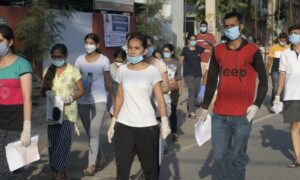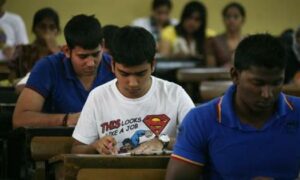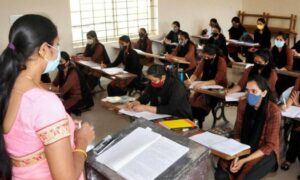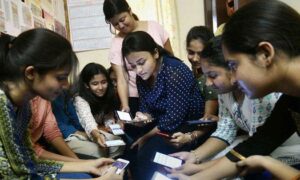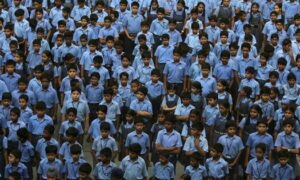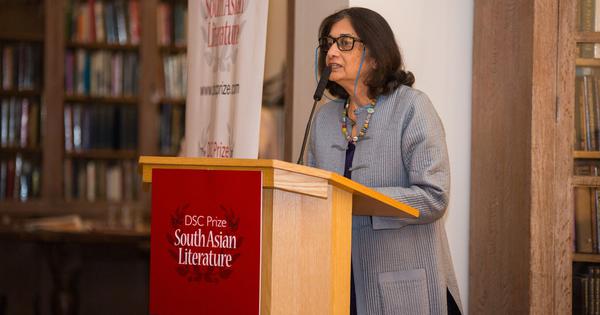
When my mother left Lahore to join my father, now posted to Delhi, she didn’t know that she would never see her hometown again. She didn’t know that our house in the Purana Qila barracks is where various members of her immediate family would arrive, in August 1947, including my grandmother, who walked out of her home, leaving behind a year’s supply of grain, jars of pickles, all her clothes and household goods, and her house keys, with a neighbour, saying she’d return soon.
She never went back. In time, the family dispersed and she divided the rest of her days between her two sons, staying with each by rotation. Independence, she would say bitterly, had rendered her homeless. That wasn’t the whole of it, though. In Lahore, she lived in the midst of an extended family in the family home compound, and although widowed, ran her household as she chose, independently. Her married daughters visited, had their children in her home (I was the only one of my siblings to have been born in a hospital, after Independence), and she made sure that her youngest son had enough resources to be able to study in England.
Now, she lived intermittently with this same son as a dependent – not financially, perhaps, but certainly in all other respects. This was an uncle I was particularly fond of and spent time with, during school and college holidays, in Bombay, when my grandmother was staying with him. Often, I would wander into her room and find her sitting quietly, dressed immaculately in white, shorn of all adornment, a picture of extraordinary dignity and forbearance. We talked, of course, but I was in my teens so could only chatter on as adolescents do. “You must work,” she would say to me, again and again, “earn your own money.” What should I do? I would reply, half jokingly. “You can become a journalist,” she replied, “you know how to write.” (She herself was illiterate, having been married at 12.) “Apni taqdeer, apni muthi vich (hold your destiny tightly in your fist),” she exhorted, and it was then that I realised what exactly leaving Lahore had meant for her. Her home gone, she no longer had a household to run; her independence lost, she had lost an important sense of her identity. She no longer had control of her life.
In the funny way that life has of handing out ironies my mother, in the early post-Partition years, felt curiously at ease in the abandoned haveli on Curzon Road that was now her sister’s home. It could be that they were both strangers to the city, both having to navigate their way through a new set of circumstances and relationships. Pre-Partition, Lahore, not Delhi, was the seat of education and culture for them; Kinnaird is where they went to college, Lawrence Gardens where they picnicked, the Mall and Anarkali, where they shopped. Delhi, in the immediate aftermath of independence, had been brought to its knees with the enormous influx of refugees into the city and the accompanying trauma of dislocation. There were camps for the displaced everywhere, even across the road from where my parents lived, in Purana Qila.
12, Curzon Road, that abandoned haveli, became a kind of refuge for both my mother and my aunt.
My mother’s jeweller, Roopchand, was in CP’s D block, I think, a narrow shop with display cases full of little boxes under not very clean glass, and opposite them, counters with watches? Or perhaps, cameras? I’m not sure which. (My Curzon Road aunt’s jeweller of choice was Kanjimull, in Scindia House; she disapproved of Roopchand, but my mother said she couldn’t afford Kanjimull’s prices.)
As a 12- and 13-year-old, I loved accompanying her when she went to get a broken gold chain repaired, a pair of earrings reset, or a necklace restrung. In the display cases were rings and ear-studs, their jewels glinting even through that not-so-clean glass. A bangle or three, set with seed pearls and rubies, were my favourites – but there were also pendants, jhumkas, a matha-patti, or the occasional gold choker; the really valuable items were kept in strong boxes, only to be shown to a serious buyer. In those days, you didn’t just drop off what you wanted repaired one day and return to pick it up when it was ready. Not at all. You couldn’t take a chance with your precious jewellery – what if it was exchanged with something fake, or the gems replaced, or a look-alike of 18 carat, not 22 carat gold be palmed off? You sat in the shop while your piece was being reset or restrung, no matter how long it took. You had a cup of tea, made small talk, exchanged a bit of gossip. Who was your jeweller before? Mr Roopchand might ask my mother. She didn’t have one in Delhi, my mother would respond, whatever jewellery she had had been bought or made in Lahore. Yes, the workmanship and designs are from there, he would agree, all the while trying to entice her to part with many thousands of rupees for that exquisite diamond necklace or that rare kundan tukra. My mother never had that kind of money.
Next to Kanjimull on Janpath was a restaurant called Laguna, which hosted the earliest kitty parties in the city. I often wondered why my mother agreed to attend them, she wasn’t really the kind of person who gossiped over coffee, but she said it was a good way of getting a jackpot at the end of one year. You put Rs 100 into the kitty every month and collect Rs 1,200 by rotation. All that for Rs 1,200? Well, it was still a decent amount in the early 1960s, and felt like more than it may have been. Whatever little jewellery my mother may have bought from Roopchand was paid for by what she saved from housekeeping money. Small amounts, over the months and years, for a pair of diamond tops, or a pearl necklace, or…
Bored with their chit-chat and having sat by the side of the patua as he restrung a necklace, I would wander off to the bookshops in B block, ED Galgotia for popular fiction and magazines, and Ramakrishna and Sons for more serious fare. Textbooks, European writers in translation, for when we were immersed in existential literature in college, or just to browse. Ramakrishna’s was another narrow space, like Roopchand’s, crowded with books that teetered dangerously on high piles or were stacked on the floor, leaving little space to move. You could stay as long as you wanted. No one asked you what you were reading, or told you to leave if you weren’t buying. Occasionally, having observed you for some time, the salesman would direct you to a book or an author he thought might interest you. All the old-timers recognised you.
Walking down the Outer Circle from Dhoomimal after seeing the exhibition, I turned a corner and stopped in my tracks: Peoples Publishing House (PPH). The corner bookshop for Left and Soviet literature, where you could buy beautifully produced and illustrated children’s books at throwaway prices, subsidised, of course, and where later I bought the three-volume What Is To Be Done? by VI Lenin. PPH was set up by the Communist Party of India in 1942, and retained its links to the party even after it became a trust in 1947. It was the publisher of Marxist and Left writings, and the source for a great deal of Soviet literature, up until the break up of the Soviet Union in 1989.
The next block over, H block, had a bookshop I also visited, mostly in my pre-teen years, St. Pauls Book Centre, but I didn’t go there for the books. It stocked mainly Christian literature, the Bible in many languages, ditto for the gospels according to Mark, Luke, John and Matthew; diaries with psalms and hymns in them; and the item I went there for—religious postcards. Jesus, Mary, the Nativity, the Crucifixion, the Resurrection. I had them all. Unlike the PPH which is now a pale shadow of its earlier self, St Paul’s is still very active, its brightly-lit interior stocking more eclectic fare, catering to a more diverse clientele.
All through the years we were growing up, buying books was a luxury. My mother was a firm believer in libraries, and all our entreaties regarding book buying fell on deaf ears. An avid reader herself, she read all the books we brought home from the Gymkhana Club library – Richmal Crompton, Norman Conquest, Biggles, Perry Mason, the Chalet School series – before we could, reading when we were at school during the day. Thanks to her, the greater part of my adolescence was spent in the children’s library at the Gym, from where I graduated to the biography room (and devoured the lives of Toulouse-Lautrec and Van Gogh, Debussy and Nijinsky), and eventually to the riches in its well-stocked stacks.
My mother’s biggest regret was that she never worked. A qualified teacher, she was a BA BT from Lahore, but my father, a commercial pilot, was away a lot, so she stayed home. She would have been a gifted teacher, even though I didn’t appreciate that fact when she wondered exasperatedly why I couldn’t wrap my head around algebraic equations or figure out simple geometry theorems. All her sisters were talented – two were amateur painters, one taught philosophy at Kinnaird in Lahore, their father’s sister played the violin—but women of their generation weren’t really encouraged to pursue a career. When I asked her why, if Shanti Buaji could learn the violin, I couldn’t continue with my piano lessons (begun in Bombay), she replied that I should try kathak, instead. What would I do with knowing how to play the piano, she asked. much more useful to learn the tabla. I didn’t, of course, but I never passed by A Godin, the piano shop next to Kwality, with a Baby Grand in the window, without a pang of regret.
Years later, I understood what my grandmother meant when she insisted that I work. It was independence that she was talking about, financial as well as psychological, and it was that very independence that my mother and her sisters didn’t have. Once, and only once, I asked my mother why she hadn’t seriously considered taking up teaching. How could I, she replied, she knew no one in Delhi. All their networks and relationships had been forged in Lahore, many left behind, others scattered as people relocated. She never said so, but I detected an undertone in her of wistful, wishful thinking at the what-might-have-beens.
I was six years old when my mother agreed to let me volunteer at an international conference of ophthalmologists in the brand-new, just-opened Vigyan Bhavan. I think of it as the beginning of my working life. As we were underage we couldn’t be paid a wage, but were given quite a decent honorarium. I bought my mother a Kota sari from Finlay’s in CP’s Outer Circle.
Excerpted with permission from ‘What is Left’ in A Stone Thrown in a Pond: Essays and Poems on the Enigma of Leaving, Ritu Menon, Women Unlimited Ink.
This article first appeared on Scroll.in
📰 Crime Today News is proudly sponsored by DRYFRUIT & CO – A Brand by eFabby Global LLC
Design & Developed by Yes Mom Hosting

